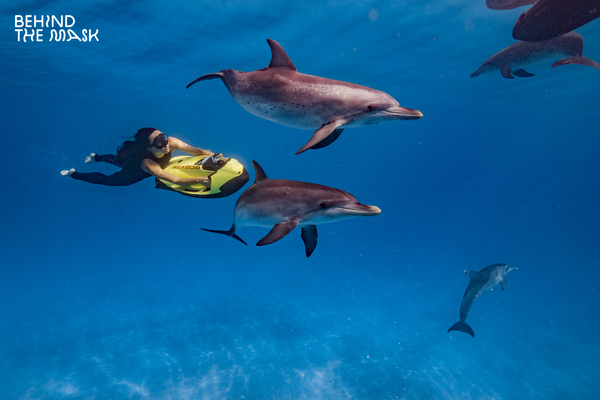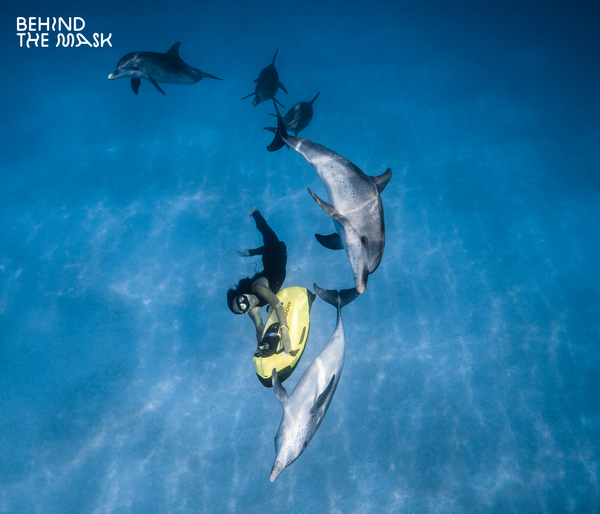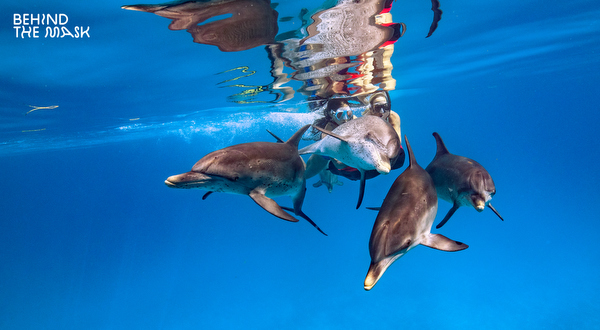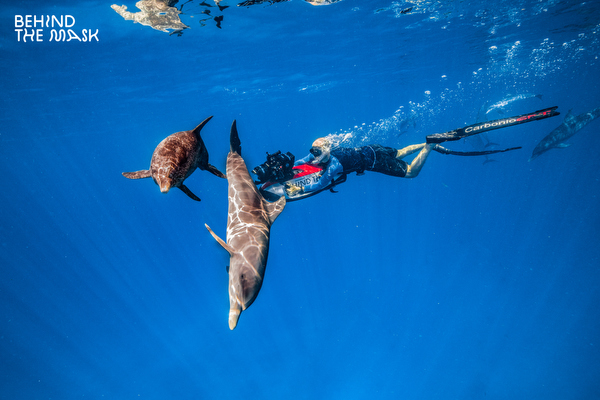Video: Aquatic Human II - BTS by Behind the Mask

The idea
Do Dolphins love Seabobs? That was the question that determined everything. The question that put a big question mark on the project. A project which we imagined so great.
The facts were simple: We had seen dolphins playing with underwater propulsion vehicles before. We had also shot with Seabobs before – freediving, scuba diving as well as with sharks. We thought, if we bring those two together, Seabobs and Dolphins, that will just be the perfect match.
From our experiences, we knew sharks weren’t the biggest fans of the speed and the acceleration of those machines. We had observed the fact, that dolphins really enjoy divers with DPVs. But Seabobs? That would be a whole different game. These underwater Ferraris reach a speed of up to 20 kilometers an hour, on the surface even more. For propulsion, they use an impeller, which is basically the same engine, a jet-ski uses. So what if the dolphins get scared? Or just annoyed?
Well, you can’t just send a couple of Seabobs to wherever there are dolphins, go there, test it, and then decide if you should come back for a full project or not. That would basically double the cost. But neither you can just set up the full thing, to then discover on the first day: Damn, the dolphins don’t like our toys.

So it was a risk, but since we couldn’t stop dreaming about it, it was a risk we were willing to take. We proposed the idea to the German company Cayago, which manufactures the Seabob scooters. At first, they were hesitating, but one day they called and said: “We want it, and we want it as soon as possible. You get what it takes. We have full trust.“
The location
It had to be the Atlantic spotted dolphins. These guys are just the best. We had played with Atlantic spotted before and knew they were way more interactive than bottlenose dolphins, for example. There is a huge population of those cheerful friends living off the coast of Bimini in the Bahamas. So the project planning involved getting all the logistics sorted out, to be able to have enough Seabobs, charter boats and accommodation available on the Islands of Bimini, and fly our team members from all around the world to the island.

With Kevin Benedict and Al Sweeting Jr., we found two boat operators in the area that both understood where we were coming from. They had worked with film crews before and could provide the logistics we needed.
The Dolphin Communication Project
In our approach, we were looking for scientific researchers who could tell us how the dolphins would react. Also, we wanted to make a hundred percent sure to treat them respectfully and not disturb them in their natural habitat. You find places in the world, where people enter lagoons, in which dolphins search for a retreat to rest, and they harass them there. We did not want anything like that.

Kelly Sweetning is a marine biologist running the Dolphin Communication Project. The non-governmental organization is based on the island of Bimini and focuses on studying and conserving the dolphin populations in the coastal waters there. Kelly was listening closely to what we planned and could give us insights into the behavior studies she had done. From her side it was easy: “Learn how to read the dolphins mood. If they like to play, you will notice that. And they if you play with them by giving them patterns, copying their movements or just racing along with them, they will love it. If they are in their private time you’ll realize it, because they won’t care about you too much.“ So we took Kelly along on the boat so that she could help us to understand the dolphin’s behavior better. In the end, she was very supportive and told us that she was glad we had the right mindset for our approach.

How to keep up with a camera
In the preparation time, we said to ourselves: Let’s assume the dolphins like the Seabobs. Let’s assume they play with it and they race along with them like they do with the bow of a boat. How in the world can a cameraman keep up with freedivers on high-speed scooters or with racing dolphins? The answer was simple: Well the guy needs a Seabobo as well. We spoke with our friends/partners at Nauticam on how they would think mounting of their flagship housing, the Weapon LT, on a Seabob would work. They were thrilled with the idea and totally supportive of the process. Ryan Canon from Nauticam USA developed the idea of a mounted ballhead on the scooter. He assembled and tested the whole concept and it worked great. Nauticam and he were also able to provide a new RED Monster 8K camera and the Wide Angle conversion Port. The wide angle conversion port basically is a wet sense that converts your semi-wide-angle-lens into a wide-angle lens. The lens we used on the main camera was a Canon 28 mm f/2.8 which was converted by the port into a 130° lens.

The Team
Florian Fischer was in charge of the main camera and managed all kinds of multitasking situations. Anticipating the dolphins, taking decisions if he should use the drone, the camera mounted on the Seabob or rather swim, to be more flexible in camera movement, but slower in following the dolphin action.
As for the protagonists we chose the winning team of our first Seabob film. Dada Li and Timo Dersch had both performed well on the Seabobs, when we shot the image film “Aquatic Human I“. They were keen to swim with the dolphins and in good shape to execute even the most challenging freediving maneuvers.

For the task of the second camera, Hamdan Chowdhury was on board. With his new Nauticam setup, including an Olympus TG-5 and a wide angle conversion port, he was able to provide high-quality behind-the-scenes-video-footage, as well as functioning as a safety-diver, for the long static-breath-hold-shots with Timo at the bottom of the sea.
And then there was Marta… Earlier this year we had run a Facebook competition for Behind-the-Mask-Followers who wanted to join one of our trips. The aim was to give people a chance who do not really have the resources to buy themselves fancy underwater-camera-gear and go on expensive dive trips but do want to get into underwater filming. It was easy. Just post a video on social media and convince us why you should come. In the end, Marta Lam from Spain, was the most convincing, and the decision turned out to be one, no one regretted.
Marta is a dive instructor with expertise in filming, so she could fit in wherever help was needed. But the best part was, she spread good mood at all times.
So we had a team of four different nationalities, flying in from four different continents, that connected with each other like pieces in a puzzle.
The execution:
Sometimes we drove around for hours to find them, sometimes we left the harbor and the dolphins were right there. When they were in the mood, it was just a blast. They followed us on the scooters, they led us the way, they copied our movements, when we were driving in circles, sometimes we turned upside down together. To observe how joyful they played was pure pleasure. “Even when they touch you, don’t touch them back“, Kelly reminded us, when we were on our way to jump in with a very playful pod. And indeed, they came so close that it was hard to avoid to making any physical contact. Sometimes it was a couple of seconds, sometimes they liked to play for an hour. It really depended on their mood. So in the final video, the narration follows a dream the diver on the bottom has, but even in real life, it sometimes felt like we were dreaming with our eyes open. Looking to the left, 10 dolphins, looking to the right, 10 dolphins, just racing along, was definitely a surreal experience out of a dream bubble.